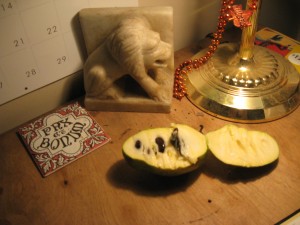 Pawpaws are the largest fruit native to eastern North America; they were part of the diet of the native Americans, but like most of the native foods of this area they are almost unknown today. The trees are not easy to grow: the seeds are favored by rodents, the seedlings can easily be killed by ultraviolet light, and they grow slowly by all accounts. The fruit does not store or ship well, and individual fruits are said to vary highly in flavor even on the same tree, which is not well suited to modern business, which likes product consistency. So it is likely that you have never eaten or even seen a pawpaw fruit – as I hadn’t when a friend gave me one this fall from his trees.
Pawpaws are the largest fruit native to eastern North America; they were part of the diet of the native Americans, but like most of the native foods of this area they are almost unknown today. The trees are not easy to grow: the seeds are favored by rodents, the seedlings can easily be killed by ultraviolet light, and they grow slowly by all accounts. The fruit does not store or ship well, and individual fruits are said to vary highly in flavor even on the same tree, which is not well suited to modern business, which likes product consistency. So it is likely that you have never eaten or even seen a pawpaw fruit – as I hadn’t when a friend gave me one this fall from his trees.
The fruits are enclosed in a tough skin which has to be cut open like a mango to reveal the soft flesh inside. The flesh has a custard-like texture, and the flavor of the pictured fruit was rather bland, and sweet, like a very insipid banana custard. I ate mine with a spoon, using the tough skin as a cup. I ate, I will confess, more with fascination and curiosity than pleasure: I take a passionate interest in wild flavors just as surely as I am apathetic to flavors produced by human process, and the pawpaw is another of the strange and uncouth flavors of the North American forest: more edible than culinary, I suppose. But I find a kind of perverse sweetness in all the bitterness of nature, as long as it nourishes me; a sensual delight in the mere fact that I am sustained roughly by a system whose beauty is not impaired by my dwelling in it.
 The pawpaw is not a major component of the eastern forests; it appears to be somewhat outmoded evolutionarily. As we all know fruits are meant to transmit seeds to the stomachs of animals, which then deposit them in distant places in small cocoons of fertilizer ideal for germination, i.e. scat. But the seeds of pawpaws are so large that even a bear would hardly swallow one whole; the evolution of pawpaws was something of a mystery until it was proposed that the giant ground sloth, an extraordinary creature which lived in North America sometime more than ten thousand years ago, was the probable vector for the pawpaw’s seeds. (Ground sloth remains are found in numbers at the La Brea tarpits in downtown L.A. The Latin name for at least one race of ground sloths is Megatherium, or “great beast.” Most of the very large North American fauna – ground sloths, mastodons, camels, tigers – went extinct relatively recently (in the tens of thousands of years), while almost no smaller species vanished at the same time, and at least one theory is that this is because of the arrival of humans, who by preference hunted big game).
The pawpaw is not a major component of the eastern forests; it appears to be somewhat outmoded evolutionarily. As we all know fruits are meant to transmit seeds to the stomachs of animals, which then deposit them in distant places in small cocoons of fertilizer ideal for germination, i.e. scat. But the seeds of pawpaws are so large that even a bear would hardly swallow one whole; the evolution of pawpaws was something of a mystery until it was proposed that the giant ground sloth, an extraordinary creature which lived in North America sometime more than ten thousand years ago, was the probable vector for the pawpaw’s seeds. (Ground sloth remains are found in numbers at the La Brea tarpits in downtown L.A. The Latin name for at least one race of ground sloths is Megatherium, or “great beast.” Most of the very large North American fauna – ground sloths, mastodons, camels, tigers – went extinct relatively recently (in the tens of thousands of years), while almost no smaller species vanished at the same time, and at least one theory is that this is because of the arrival of humans, who by preference hunted big game).
Pawpaws are now often touted by permaculturists as good garden plants because they are native, make fine understory trees, and produce food for human consumption. I’m planning on planting the seeds from this pawpaw and seeing if I can grow some trees on my property, though of course I will be in my fifties before I see any trees go from seed to fruit.
One Comment